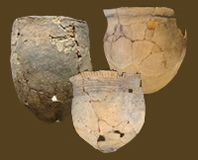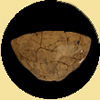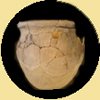
Welcome to
Prehistoric Ceramics
|
Prehistoric Ceramics in Maryland The earliest ceramics produced in the U.S were made in the Southeast around 2500 B.C. In Maryland, Indians started making unglazed, low-fired pottery a little over 3000 years ago. Initially, they experimented with different manufacturing techniques. Their first pots were made from hand-molded slabs of clay, and resembled the flat-based steatite (soapstone) bowls that were already in use at that time. In fact, these early ceramic vessels were often tempered with crushed fragments of steatite. (Temper is material – such as stone, shell, or broken pottery -- added to the clay to improve its workability and firing properties). Other tempering agents were soon being used, and the vessels started to be formed in conoidal shapes from coiled strips of clay. Before firing, the pots were often malleated (beaten) with cord or net wrapped paddles that left distinctive patterns on their surfaces. As time went on, decorations became more prevalent on the vessels. These were made by incising, direct cord impressions, and cord-wrapped stick impressions in a variety of designs. Punctations were also used as decoration, and sometimes lugs and nodules were added to the vessels. Archaeologists distinguish pottery types on the basis of tempering agents; how the exterior and interior surfaces were manipulated during construction; the shape and form of the vessel; and styles of decoration. For the purposes of the pottery definitions presented here, we are using the ware/type format standardized by Robert Stephenson in his analysis of the Accokeek Creek site collection (Stephenson and Ferguson 1963). He separated wares based on temper, and then subdivided these into types based on surface treatments and decorative techniques. Stephenson’s work was based on Clifford Evans’ (1955) efforts to categorize the types of ceramics found in Virginia and neighboring areas. While many of the types we recognize today can be found in the descriptions created by Evans, his ware names are generally no longer used in Maryland due to chronological problems that have been identified by researchers in the succeeding years. The ware names and descriptions used on this website are derived from published sources, and have been generally adopted by Maryland archaeologists. The varieties included here are among the most common types found in the region, but other wares have been found in smaller numbers. Below are links to the time periods to view the ceramic ware descriptions we have for each period.
Click here to view table of Prehistoric Pottery Types in Maryland. |
||||||||





